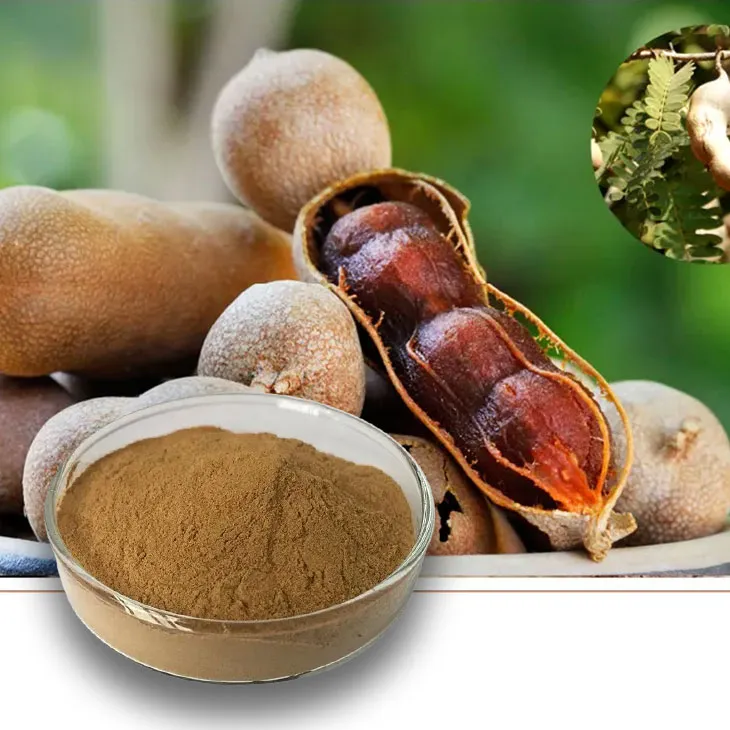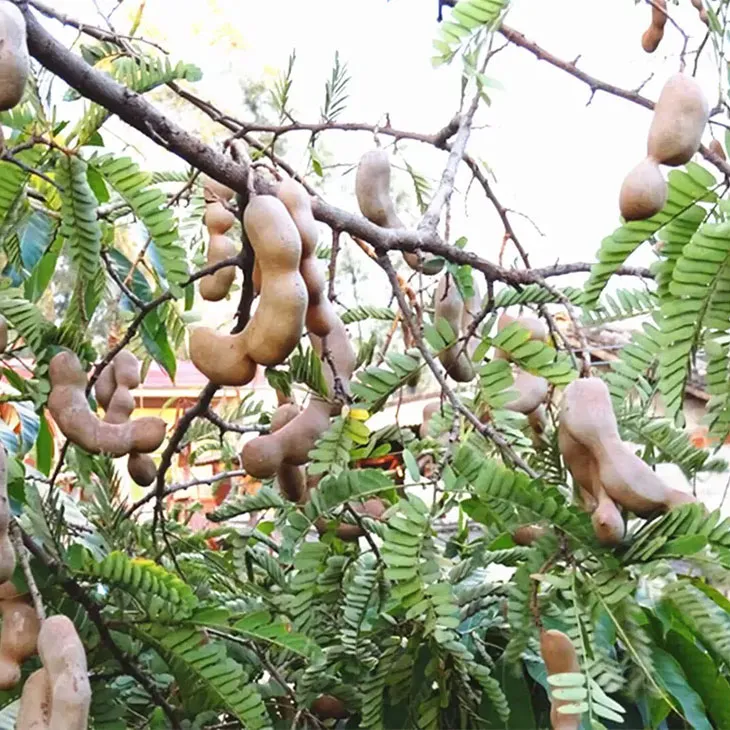- 0086-571-85302990
- sales@greenskybio.com
Supercritical carbon dioxide extraction of tamarind extract powder.
2024-11-26

1. Introduction
Tamarind (Tamarindus indica L.) is a well - known tropical fruit tree. The Tamarind extract powder contains a variety of valuable compounds, such as organic acids, flavonoids, and polysaccharides. These compounds endow the Tamarind extract powder with various properties like antioxidant, antibacterial, and flavor - enhancing capabilities. Traditional extraction methods for Tamarind extract powder often face some limitations, such as low extraction efficiency, long extraction time, and potential solvent residues. Supercritical carbon dioxide (SC - CO₂) extraction has emerged as a promising alternative in recent years.

2. Principles of supercritical carbon dioxide extraction
Supercritical CO₂ is a state of carbon dioxide where it has properties between those of a gas and a liquid. At supercritical conditions (above the critical temperature of 31.1°C and critical pressure of 7.38 MPa), CO₂ has high diffusivity, low viscosity, and adjustable density. These properties allow supercritical CO₂ to penetrate the cellular structure of tamarind effectively. It can dissolve the target compounds in tamarind and then be separated from the extract by changing the pressure and temperature conditions, resulting in the formation of tamarind extract powder.

3. Factors influencing the extraction process
3.1 Pressure
Pressure is a crucial factor in supercritical CO₂ extraction. Generally, an increase in pressure can enhance the solubility of target compounds in supercritical CO₂. For example, when extracting flavonoids from tamarind, at a relatively low pressure, the extraction yield may be low. As the pressure is gradually increased within a certain range, more flavonoids can be dissolved in supercritical CO₂ and extracted out. However, if the pressure is too high, it may lead to the extraction of some unwanted impurities, which will affect the quality of the tamarind extract powder.
3.2 Temperature
Temperature also has a significant impact on the extraction process. A higher temperature can increase the diffusivity of supercritical CO₂, which helps it to penetrate the tamarind cells more quickly. But, if the temperature is too high, it may cause the degradation of some heat - sensitive compounds in tamarind. For instance, some polysaccharides in tamarind may be degraded at high temperatures, reducing their functionality in the extract powder. Therefore, an appropriate temperature needs to be selected to balance the extraction efficiency and the quality of the extract.
3.3 Extraction time
The extraction time affects the yield and quality of the tamarind extract powder. In the initial stage of extraction, as the extraction time increases, the yield of the target compounds in the extract powder also increases. However, after a certain period, the extraction rate may slow down, and further increasing the extraction time may not significantly improve the yield. Moreover, a long extraction time may also lead to the extraction of some non - target compounds, which is not conducive to the purity of the tamarind extract powder.
3.4 CO₂ flow rate
The flow rate of supercritical CO₂ determines the mass transfer rate between CO₂ and tamarind. A higher flow rate can bring fresh supercritical CO₂ to the extraction system more quickly, which is beneficial for the extraction of target compounds. But if the flow rate is too high, it may lead to insufficient contact time between CO₂ and tamarind, resulting in incomplete extraction. On the other hand, a too - low flow rate will prolong the extraction time and reduce the extraction efficiency.

4. Quality and yield of tamarind extract powder
The quality of tamarind extract powder obtained by supercritical CO₂ extraction is mainly evaluated in terms of the content and purity of the target compounds. The yield is related to the extraction efficiency. By optimizing the above - mentioned factors such as pressure, temperature, extraction time, and CO₂ flow rate, it is possible to obtain tamarind extract powder with high quality and high yield. For example, when the pressure is set at a proper value, and the temperature is controlled within an appropriate range, along with a reasonable extraction time and CO₂ flow rate, the flavonoid content in the tamarind extract powder can be maximized, and the yield can also reach an ideal level.

5. Potential applications of tamarind extract powder
5.1 Antioxidant properties
The flavonoids and other compounds in tamarind extract powder have strong antioxidant properties. Antioxidants play an important role in preventing oxidative damage in the human body. Tamarind extract powder can be used in the food industry as a natural antioxidant to extend the shelf life of food products. For example, it can be added to oils, fats, and baked goods to prevent rancidity and deterioration caused by oxidation.
5.2 Flavor - enhancing properties
Tamarind extract powder has a unique flavor, which can enhance the flavor of food products. It can be used in the production of sauces, seasonings, and beverages. In sauces, it can add a tangy and sweet flavor. In beverages, it can contribute to a refreshing taste. Moreover, in the cosmetic industry, the unique flavor of tamarind extract powder can also be used to develop products with special scents.
5.3 Other potential applications
In addition to the above applications, tamarind extract powder also has potential in the pharmaceutical industry. Some of its compounds may have antibacterial, anti - inflammatory, and other pharmacological activities. It may be developed into drugs or health products in the future. In the agricultural field, it can also be used as a natural pesticide or growth regulator due to its certain biological activities.
6. Conclusion
Supercritical carbon dioxide extraction is a very effective method for obtaining tamarind extract powder. By carefully controlling factors such as pressure, temperature, extraction time, and CO₂ flow rate, high - quality and high - yield tamarind extract powder can be obtained. The tamarind extract powder has great potential in various fields such as food, cosmetics, pharmaceuticals, and agriculture. However, further research is still needed to fully explore the extraction process and expand its applications.
FAQ:
What are the advantages of supercritical CO₂ extraction over traditional methods for tamarind extract powder?
Supercritical CO₂ extraction has several advantages. Firstly, it is a more environmentally friendly process as CO₂ is non - toxic and easily recyclable. Secondly, it can operate at relatively low temperatures, which helps to preserve the thermally sensitive compounds in tamarind. In contrast, traditional methods may involve high temperatures or the use of organic solvents that can cause degradation of some valuable components. Also, supercritical CO₂ extraction can provide a purer extract with fewer impurities compared to some traditional extraction techniques.
How does supercritical carbon dioxide penetrate the cellular structure of tamarind?
Supercritical carbon dioxide has unique physical properties. It has a density similar to that of a liquid, which allows it to dissolve substances like the valuable compounds in tamarind. At the same time, it has a diffusivity similar to that of a gas, enabling it to penetrate the cellular structure of tamarind easily. The pressure and temperature conditions in the supercritical state can be adjusted to optimize the penetration ability and extraction efficiency.
What factors in the extraction process affect the quality and yield of tamarind extract powder?
The main factors include pressure, temperature, extraction time, and the particle size of tamarind. Higher pressure and appropriate temperature can increase the solubility of compounds in supercritical CO₂, thus affecting the yield. However, if the temperature is too high, it may lead to the degradation of some components and affect the quality. Longer extraction time may increase the yield to a certain extent, but it may also introduce more impurities. Smaller particle size of tamarind can enhance the contact area between the material and supercritical CO₂, which is beneficial to extraction.
What are the antioxidant properties of the tamarind extract powder obtained by supercritical CO₂ extraction?
The tamarind extract powder contains various phenolic compounds and flavonoids which contribute to its antioxidant properties. These components can scavenge free radicals in the body, preventing oxidative damage to cells. The supercritical CO₂ extraction method can effectively extract these antioxidant - rich compounds, making the obtained tamarind extract powder a potential source for antioxidant applications in the food, pharmaceutical, and cosmetic industries.
How can the tamarind extract powder enhance flavor?
The tamarind extract powder contains natural flavor compounds. These compounds can add a unique sour and slightly sweet flavor to food products. In the supercritical CO₂ extraction process, these flavor - enhancing compounds are efficiently extracted. When added to food or beverages, the tamarind extract powder can enhance the overall flavor profile, providing a more complex and appealing taste.
Related literature
- Supercritical Fluid Extraction of Tamarind Seed Polysaccharide: Process Optimization and Characterization"
- "Supercritical Carbon Dioxide Extraction of Bioactive Compounds from Tamarind (Tamarindus indica L.)"
- ▶ Hesperidin
- ▶ Citrus Bioflavonoids
- ▶ Plant Extract
- ▶ lycopene
- ▶ Diosmin
- ▶ Grape seed extract
- ▶ Sea buckthorn Juice Powder
- ▶ Fruit Juice Powder
- ▶ Hops Extract
- ▶ Artichoke Extract
- ▶ Mushroom extract
- ▶ Astaxanthin
- ▶ Green Tea Extract
- ▶ Curcumin
- ▶ Horse Chestnut Extract
- ▶ Other Product
- ▶ Boswellia Serrata Extract
- ▶ Resveratrol
- ▶ Marigold Extract
- ▶ Grape Leaf Extract
- ▶ New Product
- ▶ Aminolevulinic acid
- ▶ Cranberry Extract
- ▶ Red Yeast Rice
- ▶ Red Wine Extract
-
Medicinal Marshmallow Extract
2024-11-26
-
Peppermint Oil
2024-11-26
-
Epimedium extract powder
2024-11-26
-
Honeysuckle Pollen
2024-11-26
-
American Ginseng Root Extract
2024-11-26
-
Red Date Extract
2024-11-26
-
Aguaje Extract
2024-11-26
-
Lemon Extract
2024-11-26
-
Lily extract
2024-11-26
-
Bamboo Leaf extract
2024-11-26





















